To spray polyurethane, prep the workspace and surface by applying a sanding sealer, thin the polyurethane, and use the right pressure (28 PSI) and nozzle (1.0 – 1.5mm) to apply it.
Note: You can use spray-on polyurethane directly from the container without thinning or prep work.
Can You Spray Polyurethane?
You can spray polyurethane with a spray gun, airless sprayer, compressed paint sprayer, or HVLP. These painting equipment are designed with a paint cup where you can pour the sealer and pull the trigger to spray it through the nozzle.
Here are a few things you should know:
- You Must Thin Polyurethane– Polyurethane is thick, and in its thick state, it would be difficult to get it flowing through the nozzle. So, you must thin it to make it light enough so it can flow through the nozzle.
- Spray-on polyurethane is better – This is because you don’t need to thin it. In most cases, you just need to shake the can for a few seconds.
- You can’t spray all types – Technically, if you thin it enough, you can spray all types. But, oil-based polyurethane is thick, and if you heavily thin it, it will lose its natural gloss and hard finish and won’t protect a surface.
Oil-based vs. Water-based Polyurethane (For Spraying)
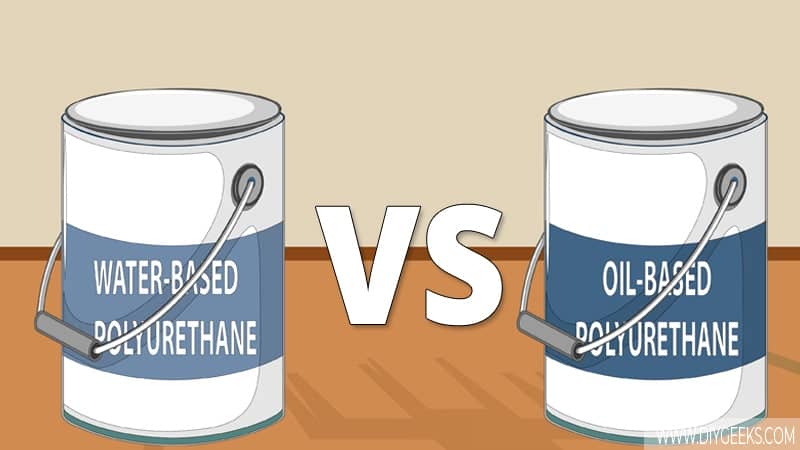
The differences between oil-based polyurethane and water-based polyurethane for spraying are listed below.
Paint Flow
Paint flow refers to the thickness of the sealer when applying it. If polyurethane has a thick flow, it won’t fit in the sprayer nozzle and you can’t spray it.
Water-based polyurethane has a thin flow because it uses water as its solvent, so the paint particles are light or thin.
Oil-based polyurethane has a thick flow because it uses oil as its solvent. Since oil is thicker than water, the oil-based type will have a thicker flow and is harder to spray.
Paint Thinner
Paint thinner refers to the solvent you use to thin the polyurethane.
To thin water-based polyurethane, use water. To thin oil-based polyurethane, use mineral spirits.
Note: Over-thinning oil-based polyurethane will remove its natural and glossy finish.
Related Read: Oil-Based vs Water-Based Polyurethane?
How To Spray Polyurethane?
To spray Polyurethane do the following things.
- Prep Your Workspace.
- Sand the Surface.
- Thin Polyurethane.
- Prep The Paint Sprayer.
- Spray the Polyurethane.
The tools you need are listed below.
- Clean rags
- Sanding sealer (for if the surface is bad or rough)
- Sandpaper
- Sprayer
- Spray shield
- A pair of gloves
- Drop sheets
- Painter’s tape
- Mineral spirits or paint thinner
1. Prep Your Workspace
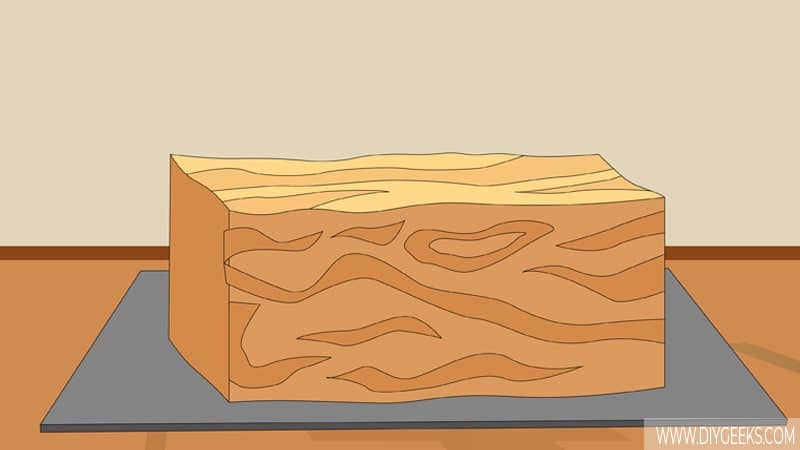
Put a large drop sheet on the floor to prevent splashes. Hold the drop sheet down on the floor using painter’s tape so it doesn’t move out of place.
2. Sand the Surface
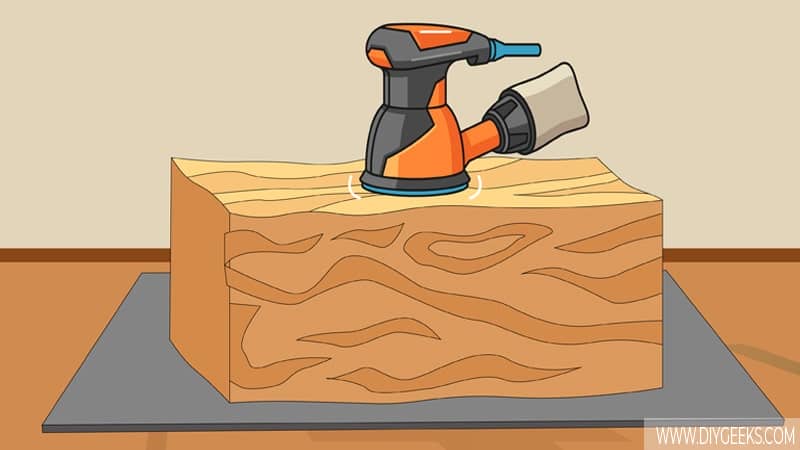
Apply sanding sealer if the surface is rough or uneven. The sanding sealer will condition the surface by covering the holes and preventing over-absorption — this leads to a smooth and even finish.
Sand the surface with fine-grit sandpaper after applying the sanding sealer. Sanding will smoothen the surface and help the sealer to stick better.
3. Thin Polyurethane
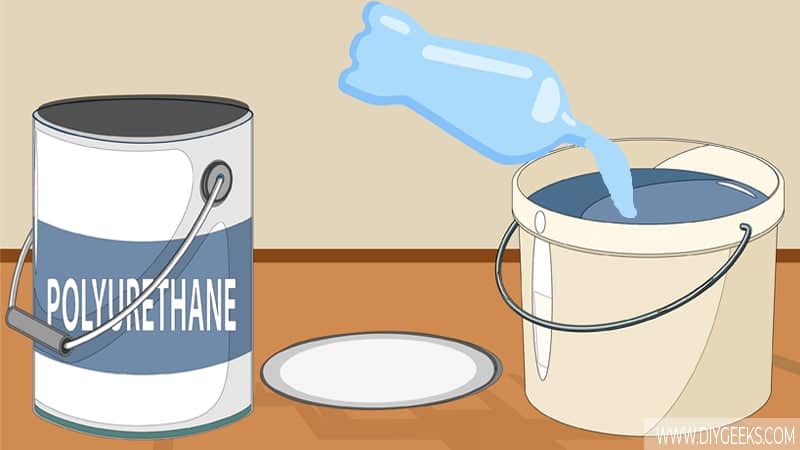
You must thin polyurethane before applying it with a sprayer. If you don’t, the thick flow of polyurethane will clog the sprayer as it won’t fit the nozzle.
To thin water-based polyurethane, use water. To thin oil-based polyurethane, use mineral spirits or lacquer thinner.
Use a ratio of 4:1 (4 parts polyurethane to 1 part paint thinner). With this thinning ratio, the sealer will have a thin flow but still maintain its hard and moisture-resistant finish.
4. Prep The Paint Sprayer
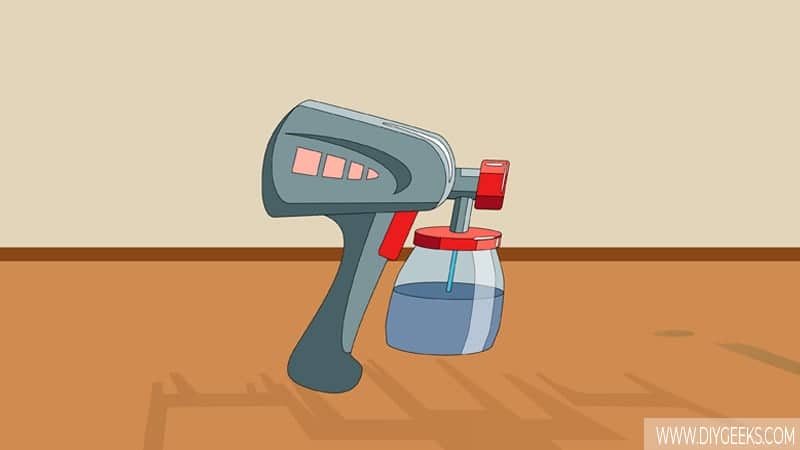
To prep the sprayer, you must clean it. prime it, and use the right nozzle tip.
For polyurethane, use a nozzle tip between 1.0 and 1.5mm. To prime it, pour polyurethane into the paint cup and switch the multi-port valve to the primer. Once the sealer starts flowing through the nozzle, the sprayer is fully prepared (and primed) and you can use it.
For spray-on polyurethane, prepping isn’t required. You just need to shake it for a few seconds and use it.
5. Spray the Polyurethane
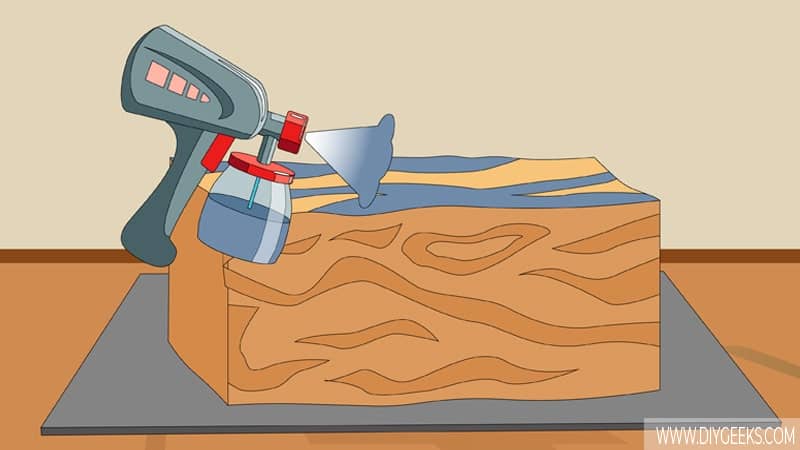
Test the sprayer to see if the finish is smooth and if it dries well. If the coating has a consistent flow and dries well, you can use it.
To spray polyurethane, use a pressure of 28 PSI. Generally, clear coats must be applied with a pressure set between 26-29 PSI. At this pressure, the sealer can be well atomized to the surface.
If you use a lower pressure than 25 PSI, the sealer won’t expel smoothly from the nozzle. Since polyurethane is thick, you must use more pressure to expel it smoothly on the surface.
While spraying, cover the surface with overlapping coats, keep the nozzle 10 inches away from the surface to avoid splashes, and apply thin coats.
You need 2-3 coats of polyurethane for proper coverage. You must allow it to dry for 3 hours before recoating. You also must sand between coats with 320-grit sandpaper. The final coat doesn’t need sanding.
You must allow the finish to dry for 3 days before using it.
Is Spray Polyurethane Good?
Spray polyurethane is a good finish and covers surfaces well, including wood. It offers moisture and scratch resistance and protects the surface from weather and UV.
Spray polyurethane is one of the strongest sealers as it has a plastic-like material that dries hard. Once it dries, the liquid layer becomes hard and moisture-resistant.
The hard layer prevents scratch marks, scars, claw marks, and dents from reaching the surface underneath. The hard layer also prevents moisture and solvents from penetrating.
Spraying vs. Brushing Polyurethane
Spraying polyurethane is better than brushing it because it is easier to apply and gives a better finish, so it can be used by beginners.
Brushing will reveal brush marks and strokes if applied by a beginner.
Here are more reasons why spray-on polyurethane is better:
- It offers better coverage over the surface.
- You don’t need to prep it.
- You can cover a surface faster.
- Covers the surface evenly.
- Doesn’t reveal brush marks.
- It is easier to apply
- It offers a better finish quality.


